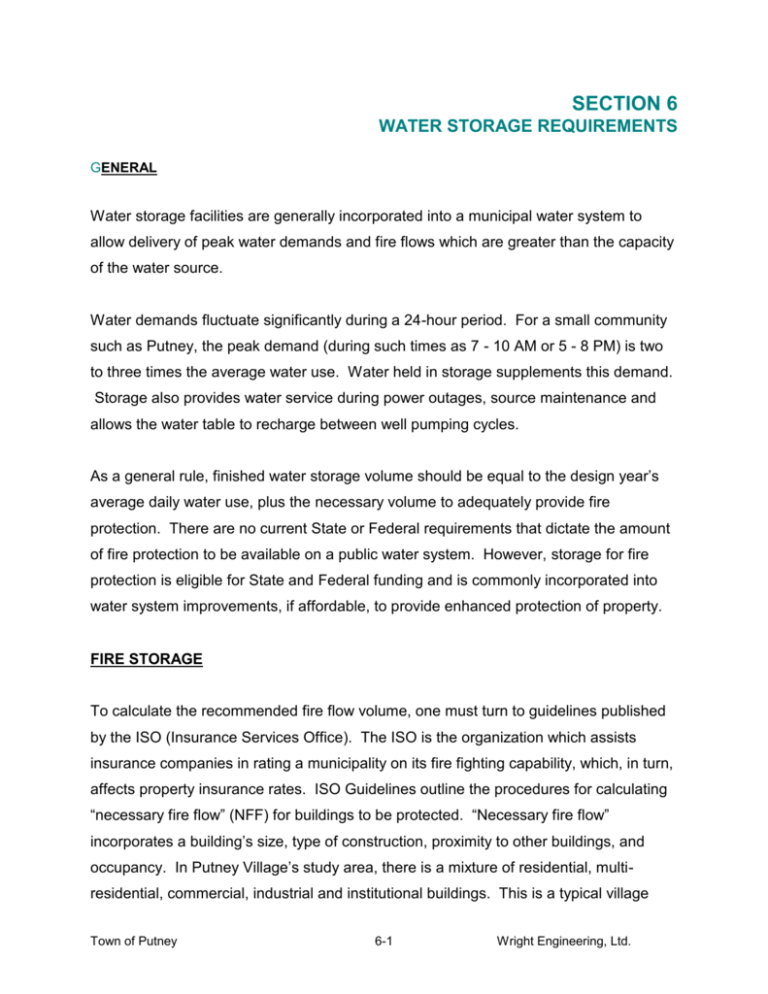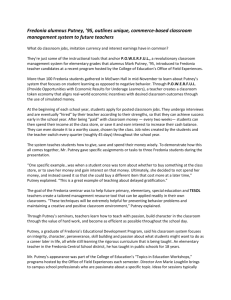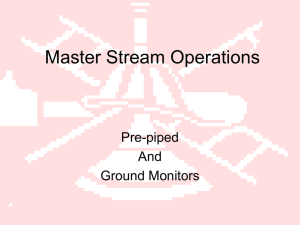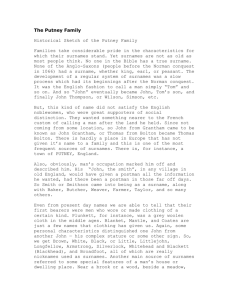section 6 - Putney Vermont
advertisement

SECTION 6 WATER STORAGE REQUIREMENTS GENERAL Water storage facilities are generally incorporated into a municipal water system to allow delivery of peak water demands and fire flows which are greater than the capacity of the water source. Water demands fluctuate significantly during a 24-hour period. For a small community such as Putney, the peak demand (during such times as 7 - 10 AM or 5 - 8 PM) is two to three times the average water use. Water held in storage supplements this demand. Storage also provides water service during power outages, source maintenance and allows the water table to recharge between well pumping cycles. As a general rule, finished water storage volume should be equal to the design year’s average daily water use, plus the necessary volume to adequately provide fire protection. There are no current State or Federal requirements that dictate the amount of fire protection to be available on a public water system. However, storage for fire protection is eligible for State and Federal funding and is commonly incorporated into water system improvements, if affordable, to provide enhanced protection of property. FIRE STORAGE To calculate the recommended fire flow volume, one must turn to guidelines published by the ISO (Insurance Services Office). The ISO is the organization which assists insurance companies in rating a municipality on its fire fighting capability, which, in turn, affects property insurance rates. ISO Guidelines outline the procedures for calculating “necessary fire flow” (NFF) for buildings to be protected. “Necessary fire flow” incorporates a building’s size, type of construction, proximity to other buildings, and occupancy. In Putney Village’s study area, there is a mixture of residential, multiresidential, commercial, industrial and institutional buildings. This is a typical village Town of Putney 6-1 Wright Engineering, Ltd. setting in which several areas have closely spaced, multi-story, wood-framed structures. Necessary fire flows for Putney properties have not yet been calculated by ISO because there is not an existing water system. However, one can estimate the necessary fire flows using ISO’s guidelines. Although municipalities do not legally have to attain these recommendations, it is often the goal of a water system improvement project to construct facilities that contribute toward achieving that goal. ISO does not recognize surface water sources, such as Sacketts Brook, as fire protection sources. From a practical point of view, however, these supplemental sources will continue to be used by the local fire department. In addition, industrial and commercial owners may install sprinkler systems in their buildings, reducing the requirements for hydrant flow and saving on insurance costs. Some buildings in Putney have their own fire suppression systems using storage tanks, fire pumps and sprinklers. Putney Paper, Basketville, the Tavern, the Putney General Store, Putney Meadows and Landmark College have existing fire suppression systems with on-site storage and fire pumps. Some of these are limited, others more comprehensive. Putney Paper uses Sackett’s Brook as a water source for its fire pump, Basketville and Landmark College have on-site water storage. If a municipal system is constructed, it is reasonable to anticipate these systems would connect to the municipal system, providing improved protection and reducing insurance costs. The minimum Necessary Fire Flow for any structure is 500 gpm. The maximum is 12,000 gpm. Using ISO guidelines (with some assumptions), Needed Fire Flows in Putney are estimated as follows: TABLE 6 ESTIMATED NEEDED FIRE FLOWS LOCATION EST. NEEDED COMMENTS FIRE FLOW Town of Putney 6-2 Wright Engineering, Ltd. Putney Paper 2,100 gpm Existing 750 gpm Fire Pump Buildings Have Sprinklers Basketville Retail 2,100 gpm Sprinklers, Existing 1500 gpm Fire Pump Capacity Basketville Factory 2,000 gpm Anticipate Sprinklers Buildings Landmark College 1,000 gpm Partial Sprinklers, Existing 500 gpm Fire Pump Town Hall 2,000 gpm Estimated Based On ISO Multi-Use District 1,000 gpm Anticipate Buildings with Sprinklers Putney General Store 2,500 gpm Sprinklers with Limited Storage and Fire Pump Putney Meadows 1,750 gpm Sprinklers with Storage and Fire Pump Putney Central School 1,200 gpm Estimated Based On ISO Putney Coop 1,000 gpm Estimated Based On ISO Putney Carriage House 1,700 gpm Estimated Based On ISO Putney Inn 1,800 gpm Estimated For 1 and 2 family dwellings, not exceeding two stories in height, the following ISO guidelines apply: ISO RECOMMENDED RESIDENTIAL FIRE FLOWS Distance Between Buildings Needed Fire Flow Over 100' 500 gpm 31' - 100' 750 gpm 11' - 30' 1,000 gpm 10' or Less 1,500 gpm Table 7, below, shows the ISO recommended duration for various fire flow ranges. Town of Putney 6-3 Wright Engineering, Ltd. TABLE 7 ISO RECOMMENDED DURATIONS FOR FIRE FLOW FLOW DURATION 500 - 2500 gpm 2 Hours 3,000 - 3,500 gpm 3 Hours 4,000 - 12,000 gpm 4 Hours Based on the estimated fire flow requirements listed above, it is recommended that 2,500 gpm be generally available in the center of the village, 1800 gpm at the south end of the system, 1,200 gpm at the north end, and 1,000 gpm at the multi-use district on River Road. TABLE 8 WATER STORAGE VOLUME OPTIONS Meeting Highest Estimated Fire Flow Meeting 2nd Highest Estimated Fire Flow Meeting 3rd Highest Estimated Fire Flow Average Daily Water Use, Year 2030 100,500 gallons 100,500 gallons 100,500 gallons Fire Storage: 5,500 gpm/4 hours 300,000 gallons 4,000 gpm/4 hours 240,000 gallons 3,750 gpm/3 hours 180,000 gallons 3,000 gpm/3 hours TOTAL STORAGE Town of Putney 400,500 gallons 6-4 340,500 gallons 280,500 gallons Wright Engineering, Ltd. A storage volume of 300,000 - 400,000 gallons is certainly common for similarly sized Vermont water systems and is reasonable for Putney. Therefore, it is the Engineer’s recommendation that Putney consider 400,000 gallons of total storage volume, sufficient for the historic village buildings, Basketville, the school and the many businesses and homes in the study area. TYPES OF STORAGE CONSTRUCTION There are numerous types of water storage tanks. Commonly used types in Vermont are: Poured-In-Place Concrete Pre-Stressed, Pre-Cast Concrete Glass-Fused-To-Steel Welded, Painted Steel Photos of these types of tanks are provided on page 6-7. A summary of the advantages and disadvantages of each type are listed on Table 9 on the following page. Typically, communities requiring the amount of storage projected for Putney select either a pre-stressed, pre-cast concrete tank, a poured-in-place concrete tank, or a glass-fused-to-steel tank. Bolted, painted steel tanks are not recommended due to the need for repainting, a costly and time consuming venture for a small community, requiring the tank to be emptied and “off-line”. In Putney’s case, an above ground glass-fused-to-steel tank would not be recommended due to the significant fire storage volume which may lead to freezing issues. Concrete tanks can be either partially or entirely buried, mitigating freezing and aesthetic issues. Town of Putney 6-5 Wright Engineering, Ltd. TABLE 9 SUMMARY OF ALTERNATIVE WATER STORAGE TANKS - 400,000 GALLONS POURED-IN-PLACE PRE-CAST, PRE-STRESSED PAINTED, WELDED GLASS-FUSED-T0- CONCRETE CONCRETE STEEL STEEL Maintenance Minimal Minimal Requires costly interior and exterior repainting ever 15 - 20 years Minimal Expandability Another chamber could be added on in future, if provisions are made in initial design None None Additional panels can be added to raise height (volume) of tank. # of Chambers Unlimited, normally two One One One Vandalism Potential Negligible Negligible Can be shot through with rifle. Can be shot through with rifle. Can be damaged by rock throwing. Freezing Can be partially or completely buried eliminating freeze potential. Can be partially or completely buried eliminating freeze potential. Relies on minimum 1/3 total volume turnover to keep water temperature above freezing. Surface ice will form. Cannot be buried. Relies on minimum 1/3 total volume turnover to keep water temperature above freezing. Surface ice will form. Cannot be buried over 6' above floor. Possible Dimensions for 400,000 gallons 2 cells Each: 50' x 50' x 12' Total Tank: 100' x 50' x 12' 65' diameter X 16' 48' diameter x 30' high 65' diameter x 16' high Town of Putney 6-6 Wright Engineering, Ltd. Town of Putney 6-7 Wright Engineering, Ltd. 650,000 gallon Poured in Place Concrete Tank Village of Barton 250,000 gallon Pre-Stressed, Pre-Cast Tank - Graniteville Fire District #4 850,000 gallon Glass-FusedTo-Steel Tank - Village of North Bennington Town of Putney 6-8 Wright Engineering, Ltd. REQUIRED ELEVATION A gravity water storage tank needs to be located at an elevation high enough to supply minimum regulatory water service pressures throughout the water system. For public water systems these minimum pressures are 35 psi under normal conditions and 20 psi under fire flow conditions. Consideration must also be given for those buildings with (or considering) sprinkler systems, since most sprinkler systems require at least 50 psi to function properly. Based on the proposed service area, illustrated on the exhibit in Appendix A, the highest water service location will be the Landmark College dormitories with a second floor elevation of approximately 485 feet USGS. To maintain 50 psi in these buildings with sprinklers, a water storage tank must be located at a minimum elevation of 600 feet. Allowing for headlosses and a partially buried tank, it is recommended that a storage site with a ground elevation of 620 feet USGS be selected. POTENTIAL LOCATIONS Given the topography in and around Putney Village there are four general areas high enough to locate a water storage tank. Three of these areas are highlighted on the Appendix A exhibit. During this study all sites were field visited. Landmark College A hill northeast of the Landmark dormitories rises to a suitable elevation and has several plateaus on which a storage tank could be constructed. The ideal site would be near the top of an abandoned ski lift which is accessed by an existing woods road. Overhead electrical power extends to this site, reportedly to serve proposed college facilities, plans for which are now abandoned. Looking at this site from several vantage points, it appears the Landmark site would not be visible from any location in the Village. The Town Plan indicates Town of Putney 6-9 Wright Engineering, Ltd. the softwood area above the tank site, and extending along the ridge to the northeast, is a deeryard. However, construction of a water storage tank on the fringe of this deeryard should not have a negative impact on the integrity of the deeryard as there would be little clearing, and no lighting or public access. Fred Houghton Road A small knob of land on the east side of Fred Houghton Road is above the required 620 foot elevation. However, this property is in private residential use and would require 2,500 feet of water transmission main down Fred Houghton Road to the service area. Given the rural residential use of this site, anticipated land acquisition costs, impact on adjacent properties, visibility, and the cost of the transmission main down a narrow Class 3 road, this site is ranked below the Landmark site. Signal Pine Road The land on both sides at the top of Signal Pine Road is at the necessary elevation for a water storage tank. However, like the Fred Houghton Road site, this is a rural residential area accessed by a narrow Class 3 town road. For the same reasons stated above for Fred Houghton Road, the Signal Pine Road site is ranked below the Landmark site. Route 5 North A large land mass above elevation 620 feet is located on the west side of Route 5, north of Sand Hill Road. However, this area is very steep, difficult to access, privately owned and would require a transmission main constructed along the west side of Route 5 in the State highway right of way. Deep drainage ditches and steep side slopes in this location would make the transmission main construction difficult and expensive. In addition, a tank on this hillside, unless located far into the property, would be easily visible from Route 5. For these reasons this site is also ranked below the Landmark site. Town of Putney 6-10 Wright Engineering, Ltd. For the various aesthetic, cost and environmental reasons stated, the Landmark College site is the recommended site for a water storage tank serving Putney village. Town of Putney 6-11 Wright Engineering, Ltd.








